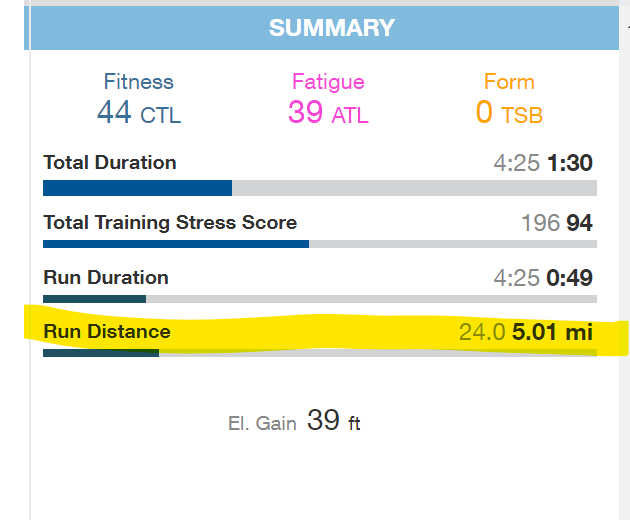Hal Higdon, Galloway, NAZ Elite, Run Less Run Faster, Couch to 5k. All big names in the world of training plans for runners. But which one should you choose? I’m not actually going to tell you which one to choose today. What I am going to do is give you 5 key components every single running training program should include. So when you’re comparing plans, you can use this as a sort of checklist before making your decision!
Weekly Volume with Safe Increases
Weekly volume just means how many miles you’re running in a week. The general rule of thumb is that weekly volume shouldn’t increase by more than 10% each week, though there are some exceptions to this rule in both directions (less than 10% and greater than 10%).
If your plan has you doing a weekly volume of 10 miles and the following week it jumps to 20 miles, that should be a major red flag. Increasing volume too fast can lead to injury. We need to build up to those high volume weeks.
It’s also worth noting that if you’re just starting out running, you’re going to want to increase even slower. Your cardiovascular fitness will improve quickly and you’ll feel like you can do more, but your skeletal muscular system doesn’t adapt as quickly. Which is why the majority of running injuries occur in new runners. We have to allow the skeletal and muscular systems to adapt and get stronger.

Weekly Volume Broken out Across the Week
The next thing you should be looking for is how the weekly volume is broken out across the week. If you have a 20 mile week and only two 10 mile runs, that might not be the most effective and safe way to train.
This also has to work with your schedule. Many running plans will have you running 5-6 days/week, but that’s not always realistic for people.
I like to program 3-4 days of running for my clients along with cross-training (we’ll get to that, keep reading). I’ve found in my years of running that 3-4 days of running is effective at achieving the training adaptations most people are going for (exception would be an elite level runner).
So take a look at the way volume is broken out and if it fits with your lifestyle and allows for enough recovery between runs.
Some notes: We really only want one long run per week, one higher intensity workout, and the rest should be shorter, easy runs.
Training Blocks
Every running training plan should have blocks of training. Typically these blocks would be 4 weeks long with 3 weeks of building and one week of recovery.
If the plan you’re looking at isn’t building in recovery or back-off weeks, I’d skip it.
Recovery weeks are so important to allow our bodies the opportunity to full recover from the work we’ve put in the last 3 weeks. Running puts stress on our body. We need to let it rest and recover so we can continue to build. Tear it down, let it recover, build it back up even stronger. That’s the theme here.
Some training plans will vary in the length of the training blocks which is okay. Just make sure those recovery weeks are there.

Rest Days
Speaking of rest and recovery…
Your training plan should absolutely include rest day(s) each week. You should have at least one full rest day each week. Again, your body NEEDS to be able to recover and if we just push full-steam ahead every single day it’s never getting that vital recovery time. This leads to overtraining and injury.
I think rest days are something a lot of runners really struggle with, but trust me. They are magical and will make you a better runner. Take. Your. Rest. Days.
Strength Training Sessions
Every single running training plan should include 1-2 strength training sessions per week. And these strength training sessions shouldn’t just be “upper body” and “lower body”. They should include exercises specific to running and they should follow a progressive program just as your running will.
Strength training will make you a better runner. It will make you stronger, which will allow you to generate more power, which will make you faster. And it will help prevent injury by correcting any muscle imbalances you may have. We all have them.
A good coach will evaluate you for those muscle imbalances and then program your strength training to address these.
This is where I think most running plans lack. Which is why it’s a good idea to get your own running coach who can write this specifically for you.

So I said I wouldn’t give you a solid answer on what plan is best, but I’m not just going to leave you hanging. I put together a sample 4-week block training plan for you from yours truly.
Couple of notes on this:
- This is not a beginner training block
- Your long run volume should be at 6 miles (meaning you’ve run 6 miles in the last week)
- You will need dumbbells for the strength training
- This isn’t a customized plan so may not be right for you, but will at least give you an idea on what it’s like to train with me!
Remember: this post is for informational purposes only and may not be the best fit for you and your personal situation. It shall not be construed as medical advice. The information and education provided here is not intended or implied to supplement or replace professional medical treatment, advice, and/or diagnosis. Always check with your own physician or medical professional before trying or implementing any information read here.


0 Comments